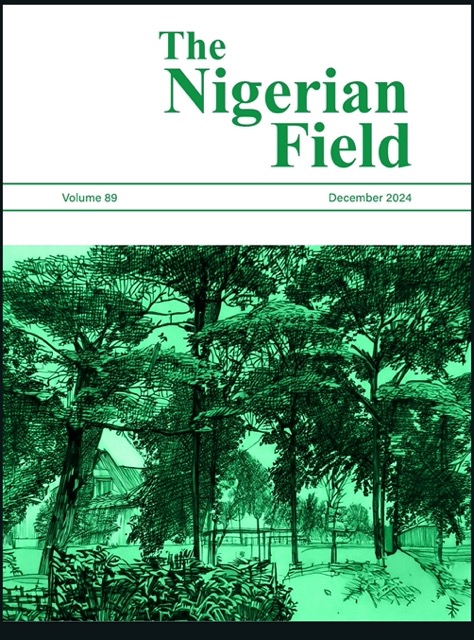The Nigeria Field, Volume 89
Editorial
Augustine O. Isichei
Politically, Nigeria consists of 36 states and the Federal Capital Territory. While the 36 states have governors as their chief executives, the FCT has a minister appointed by the president as the political head. Being the FCT minister has proved a glamorous job and all ministers so far appointed are always in the media not only due to being where all the national political actions happen but also because of the patronage at the control of such a politician. FCT has been very much in the news recently because of demolitions of properties constructed ‘not according to the ‘Master Plan’’. When the decision was taken
in the mid 1970’s to move the seat of government in Nigeria from Lagos, a body was constituted to draw up a Master Plan for the new capital. The Federal Capital Development Authority (FCDA), as the planning authority was called, allowed a compilation of the flora of the 8000 km2 territory. FCT has seen massive infrastructure development and most of the original vegetation is now lost. The compilation of the flora of the territory as at 1981 is presented in this Volume. It is hoped that all the intrigues surrounding land allocation and property may someday recede and that there will be more talk on conservation and landscape aesthetics, and the paper published here may be found useful. One of the names that featured as a collector of plants, specifically Cyperaceae in the then wild new capital territory was John B. Hall, an ecologist and a forester who worked in Nigeria and Tanzania. Prof. had written on the sedges of Nigeria and West Africa in our last two volumes. In the present Volume the geographic basis of sedge phytogeography previously explored for Nigeria and the West African region is scaled-up and consideration extended over an “Africa Domain” and West Africa is compared with the rest of Africa. Barry Hughes, one of the iconic figures of the The Nigerian Field comments on an earlier collection of snakes from Ghana. He cautions on wording of titles, the use of scanning technology to pluck data from the literature without questioning its validity and the need to look at voucher specimens for authentication of taxonomic identification.
Orí-Olókun, a brass sculpture, excavated from Olókun grove in Ile-Ife in 1910 is a well-known antiquity. This work of art represents the totality of Olókun, the Yorùba goddess of the sea. Olókun is also referred to as the deity of health, wealth and prosperity. Dr. Kehinde Adepegba tells us in this Volume that Orí-Olókun figure is not the only symbol of Olókun cult and worship, but a proper understanding of the socio-aesthetic values of Orí-Olókun figure speaks volumes about the mythology of Olókun and its importance to creativity in Yorùba art.
As the year 2024 draws to a close we recall with apprehension the fact that the UK Branch of NFS will wind down in a matter of months from now, in 2025. We will lose a major part of the ‘principalities and powers’ of the Nigerian Field Society. The winding down is understandable but which child easily accepts being weaned? We can only reluctantly say good bye to the Branch and hope that the ageing members who mentored the Society for so long will continue to support us with the wisdom that sustained them and the society for almost a century. We expect that the remnant of the UK branch will nurture the offshoot that should take the place of the Branch.
Despite the harsh economic conditions, the surviving Branches of the Society in Nigeria are making impact in their localities as the Branch reports show. The Ife and Warri braches showed very encouraging vitality this year. Our journal continues to remain the flagship of the Society and members of the Board remain shining lights. The Chairperson, Dr. Pat Oyelola turned 86 years old in November while Prof. D.U.U. Okali, a member of the Board and former President turned 89 in September. These two individuals continue to render vital services as paper reviewers. We wish them unflagging strength. I very sincerely appreciate the contributions, in many ways, of the NFS Honorary Secretary, Dr. Steve Folaranmi toward the production of this Volume
This Volume is being produced close to Christmas and as we are full of hope, we say merry Christmas and a prosperous new year!
Full Editorial: The Nigeria Field, Editorial Volume 89
Articles
AUGUSTINE O. ISICHEI
The Nigerian Field (2024) 89:8–28
Kehinde adepegba, Ph.D
The Nigerian Field (2024) 89:29–49
John B Hall
The Nigerian Field (2024) 89:42–63
Barry hughes
The Nigerian Field (2024) 89:64–76
Olatunde Obasola
The Nigerian Field (2024) 89:77
Jen Maddison
The Nigerian Field (2024) 89:78
Branch reports
Esther Nwani
The Nigerian Field (2024) 89:79–81
Ile-ife branch: 2024 annual report
The Nigerian Field (2024) 89:82-83

